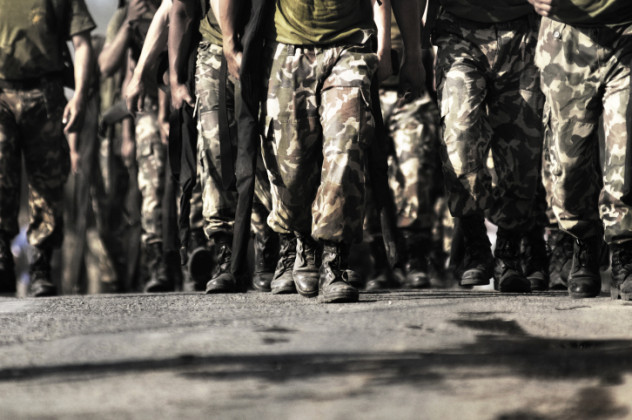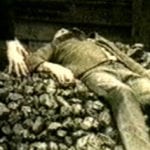 Mysteries
Mysteries  Mysteries
Mysteries  History
History 10 Surprising Stories About the Texas Rangers
 Humans
Humans 10 Philosophers Who Were Driven Mad by Their Own Theories
 Miscellaneous
Miscellaneous 10 Video-Game-Worthy Weapons and Armors from History
 Weird Stuff
Weird Stuff 10 Psychics Who Accurately Predicted Wartime Events
 The Arts
The Arts 10 Pieces of Art Inspired by a Broken Heart
 Health
Health 10 Science Fiction-Sounding New Medical Treatments
 History
History 10 Surprising Facts About the Father of Submarine Warfare
 Space
Space Ten Astonishing New Insights into Alien Worlds
 Weird Stuff
Weird Stuff 10 Bizarre Summer Solstice Rituals Still Practiced Today
 Mysteries
Mysteries Top 10 Haunting Facts About the Ghost Ship MV Alta
 History
History 10 Surprising Stories About the Texas Rangers
 Humans
Humans 10 Philosophers Who Were Driven Mad by Their Own Theories
Who's Behind Listverse?

Jamie Frater
Head Editor
Jamie founded Listverse due to an insatiable desire to share fascinating, obscure, and bizarre facts. He has been a guest speaker on numerous national radio and television stations and is a five time published author.
More About Us Miscellaneous
Miscellaneous 10 Video-Game-Worthy Weapons and Armors from History
 Weird Stuff
Weird Stuff 10 Psychics Who Accurately Predicted Wartime Events
 The Arts
The Arts 10 Pieces of Art Inspired by a Broken Heart
 Health
Health 10 Science Fiction-Sounding New Medical Treatments
 History
History 10 Surprising Facts About the Father of Submarine Warfare
 Space
Space Ten Astonishing New Insights into Alien Worlds
 Weird Stuff
Weird Stuff 10 Bizarre Summer Solstice Rituals Still Practiced Today
10 Suspicious Unsolved Military Mysteries
There are over 3,000 cases of military servicemen who commit suicide every year in the United States and over 1,000 murders. These murders often go unsolved, and for some families whose loved ones supposedly committed suicide, the evidence simply doesn’t add up.
10Paul Whipkey

In the early 1950s, Lieutenant Paul Whipkey found himself in a high position within the United States Air Force at Fort Ord, California. He was one of the first men to witness the atomic bomb tests. In 1957, he began acting strangely. He also lost all of his teeth, suffered from constant colds, suddenly lost weight, and developed black moles and warts all over his body. While on post, he was often seen talking to two men dressed in suits, but they have never been identified. Colleagues noticed that he was often tense and not himself after seeing them.
On July 10, he told his friends he was visiting the nearby city of Monterey. He left in plain clothes and never returned. The day he went missing, he had checked into a hotel 560 kilometers (350 mi) away. A day later, a man dressed in military clothing was seen driving Whipkey’s car. That same day, the Army quickly cleared out his apartment. A month later, after no sign of his whereabouts had surfaced, he was classed as a deserter. It took eight more months before the military began to search for him. His car was found in Death Valley with the keys still in ignition and surrounded by cigarette butts, which was suspicious because he didn’t smoke. Even more suspiciously, the Army destroyed all files on Whipkey in 1977. Years later, seemingly out of nowhere, they changed his status from a “deserter” to “killed in action.”
There are many theories on what happened to Paul Whipkey. Even after he started to behave strangely, his family and colleagues insist that he was a perfect soldier who was unlikely to have deserted. Some theorize that he was recruited by the CIA and died in a secret mission, while others believe there was a military cover-up after he died of radiation poisoning.
Think you know it all? Find out what the military does beneath the eye of the public in the chilling book Dirty Little Secrets: Military Information You’re Not Supposed To Know at Amazon.com!
9Chad Langford

Chad Langford was a military police officer stationed in Alabama in 1992. Just before his 21st birthday, he had broken up with his girlfriend but was seeing other women and seemed happy about his life, making plans to reenlist. However, on March 2, he made a frantic call to his father. He told his dad that he was doing undercover work involving guns and drugs and that he would be a “dead man” if anyone found out.
His father encouraged him to speak to his undercover superior, but Langford told him that he couldn’t contact him for another 14 days. His friends reported that his behavior changed over those few weeks—he pierced one ear, began wearing “gangster” clothes, and hung around with rough-looking people. Three soldiers claimed they overheard him making plans to steal from the Army trading post.
On March 12, 1992, Langford was on duty. Thirty minutes before his patrol was supposed to end, he sent a radio message informing his colleagues that he was stopping to help a motorist. Minutes later, he called for backup. When the backup arrived, the first thing he saw was Langford’s belongings strewn all over the road—his ID tag, armband, and radio had been arranged in a line. A few meters away, Langford was lying on the road with a gunshot wound to his head. He was still breathing but could not speak, and succumbed to his injuries before he got the chance again. His death was ruled a suicide.
His family, however, isn’t buying it. In addition to his future plans and alarming phone call, there is plenty of evidence of foul play. His belongings that were found in the street were covered in unidentified fingerprints and none that belonged to Langford. When he was found, his cap had been stuffed into his mouth, cords and straps had been wrapped around his neck and ankles, his left hand had been handcuffed, and the words “March 3 Robert” had been written on his hand. Langford’s handgun was found underneath his left shoulder. Two shots had been fired from it, but ballistic investigations never confirmed whether they hit him. A little over an hour after the incident, two cars were stopped by other military police officers. The names of the drivers were never written down, but one called himself Robert. Langford’s family has demanded another investigation, in light of these details.
8Kirk Vanderbur

Kirk Vanderbur was a college student with dreams of starting a big family. He used the money he earned from serving in the Marines to pay for his college degree and began collecting Disney films to hand down to his children. In 1992, he was stationed at Camp Lejuene in North Carolina, preparing to be sent overseas. On Valentine’s Day, he asked his mother to send him homemade cookies and renewed his Playboy subscription. Two days later, he walked to the Flatwoods gun club to spend an afternoon on his target practice.
It was initially believed that Vanderbur was alone when he arrived at the gun club. The club’s manager, Laretta Wager, had some errands to run, but Kirk promised that he would clean up after himself and lock the building when he left. When Laretta returned the next day, she noticed that his car was still there. The doors were all closed except for the driver’s side, and the keys were in the ignition. Kirk had recently installed a car alarm and always kept it on. Inside, she discovered Vanderbur’s body with a gunshot wound between his eyes.
Since his thumb was loosely round the trigger of his gun, the death was immediately ruled a suicide. However, when the paramedics rolled him over, they discovered another wound in his abdomen. The ruling was revised to state that he had accidentally shot himself in the stomach while cleaning his gun, and the pain was so intense that he committed suicide.
Other evidence doesn’t add up, though. There was gunshot residue on his forearm, suggesting that he had tried to protect himself. No fingerprints were found on the guns or nearby objects. A brown bag covered in blood splatter was discovered but not sent off for analysis. Outside investigation later revealed that his thumb would not have been able to reach the trigger in the position described in the original investigation and that two other men, who have never been identified or questioned, accompanied him to the gun club.
Theories have ranged from a botched investigation to a compromised crime scene to murder. His family and several Marine friends are certain Vanderbur was murdered and have vowed to find out the truth about his death.
7James E. Sabow

James Sabow was a highly decorated jet pilot who had flown in over 200 missions. In 1991, he was promoted to the position of colonel. The same year, he found out that military planes were being ordered to fly to El Toro in the middle of the night, supposedly to transport weapons. When he expressed concern to his superiors, Commander Thomas Adams and Chief of Staff Joseph Underwood, they told him that these planes were transporting weapons to South America in exchange for drugs.
Sabow threatened to tell the authorities, and that night, he called his retired former general and told him everything. General J.K. Davis immediately called Washington, and a team was sent out to San Diego to stop the drug trafficking. However, Davis also made a phone call to Sabow’s commander, Thomas Adams. As a result, Adams relieved Sabow and Joseph Underwood from their duties before filing charges against them for “carrying extra baggage” on planes. The next day, Sabow received an unusual phone call. He was found dead in his garden an hour later, having been shot in the mouth.
His death was immediately ruled a suicide, but his brother was not convinced and set up his own investigation. There was a suspicious lack of blood on the floor where Sabow’s body was found, and independent autopsies eventually revealed that he received a blow to the head from a blunt object that damaged his skull and rendered him unconscious before he was shot. Many of those who have attempted to help Sabow’s brother uncover the truth have been approached and threatened by military officials. In 2012, it was revealed that the official autopsy photos that had been taken of Sabow’s body had been tampered with to hide markings on his body that would suggest he was beaten up before being shot.
Sabow’s family and most of those who have subsequently investigated his case are absolutely unconvinced that he committed suicide. The forensic evidence and motivations highly suggest otherwise, but the military refuses to look into any other possibilities.
Dig into a disturbing, paradigm-shifting vision of 20th-century history with this eye-opening book of CIA secrets. Buy Whiteout: The CIA, Drugs and the Press at Amazon.com!
6Yosef Alon

Yosef Alon was born in 1929 in Czechoslovakia. After the war, he attempted to carry on his father’s jewelery business, but he volunteered to become a pilot in the Israeli Air Force in 1947. He spent 20 years in Israel, and by the 1970s, he was so respected in the community that he was nominated for a high-profile position in Washington for the Israeli Embassy. Alon’s expertise as a fighter pilot who had served nearly 75 missions during the War of Independence was highly regarded in Washington, and he spent a lot of time working on armament projects, such as the F-4 Phantom.
On June 1, 1973, Alon and his wife, Devora, had attended a dinner party at the Israeli Embassy. In the early morning hours of their return to their home in Maryland, Devora heard five shots as she walked in the door. When she looked outside, she saw an unknown man running into a light-colored van, which then sped away. She then saw her husband lying in a pool of blood. Devora called the police while her two daughters attended to their father, but Alon died at the hospital less than half an hour later.
Despite national media coverage and the personal interest of Henry Kissinger, who was the secretary of state at the time, no suspects have ever been identified for Alon’s murder. The case has proven a fertile ground for conspiracy theories, including the possibility that Alon was part of the Israeli Intelligence Agency or that he was killed because he discovered that the Israeli Defense Minister was spying for the US. Some have even speculated that the murder was romantically motivated.
5William Donald Miller

William Miller was a US Marine Corps sergeant and the eldest of the six Miller children. He grew up in Wisconsin, riding bikes and horses and climbing trees. After leaving school, he followed in his father’s footsteps and joined the Marines, eager to start his own career. By 1972, he had three daughters—two from a previous marriage and a one-year-old girl with his new wife, Vickie.
While her husband was in Okinawa, Vickie rekindled her love affair with her childhood sweetheart, George Hayden, who was also in the Marines. When Miller returned home to find that Hayden had moved his mobile home next to Miller’s house, he beat Hayden and told him to leave. When Hayden refused to move, the sheriff was called, but Vickie chose to leave with Hayden and took her young daughter with her. Miller wasn’t prepared to lose custody of another child and began compiling evidence against the two, which he kept in a box that he gave to his neighbor. Hayden responded with threats of violence.
On September 16, Miller received a call from Vickie, who explained that she was having car trouble and asked him to meet her in a parking lot. Miller borrowed his neighbor’s car and left with a pistol, just in case it was an ambush. That night, a passing merchant saw the car that Miller was driving parked on the side of the road next to a maroon Chevrolet similar to the car Hayden owned at the time and another unidentified car. Miller was later found dead by two motorists, having been shot in the right temple and the back. Miller’s gun was left half-cocked in his car, which still had the engine running and the headlights on. Two M-16 shell casings were found by his body.
To many, the answer to this “mystery” seems obvious. Hayden’s alibi was inconsistent—he said he was watching TV, while Vickie said he was out buying one because they didn’t have a television. However, they weren’t arrested until 36 years later, and there was to be one more twist in the tale. After high media coverage of the trail, a former babysitter for the Millers came forward to say that a previously unmentioned man—her ex-boyfriend and former Marine, Rodger Gill—had told her that he witnessed the shooting. The reason he was there has not yet been revealed. The next year, the convictions against Vickie and Hayden were overturned, and no additional suspects have been detained.
4Gareth Williams

In 2010, Gareth Williams was a mathematician working for GCHQ but had recently been issued a secondment to work at MI6. He grew up in Wales and had excelled at school, finishing a first-class degree at the age of 17 before he completed his A-levels. He started a PhD in Manchester but decided to drop out, finding employment in London with the government. According to friends, he was incredibly introverted and liked to keep to himself, as well as reportedly asexual. For over a decade, he worked as a cipher and code expert.
In the early months of 2010, Williams had voiced concerns that he was being followed. On August 23, colleagues requested that the MI6 conduct a welfare check, as he had not contacted his work for several days. When police arrived, they found his decomposing body, naked and locked into a North Face holdall in his bath. Coroners initially ruled that Williams had most likely been murdered, but the police insist that the death was the result of kinky sex gone wrong.
The evidence points quite conclusively toward foul play. Coroners ruled that it would have been impossible for Williams to lock himself into the bag, and there were no fingerprints found on the edges of the bath, suggesting that he did not lower himself in. In fact, there were no identifiable fingerprints found in the apartment at all, suggesting that it had been thoroughly cleaned beforehand. There were no drugs or alcohol in Williams’s body, but a mysterious white powder was found throughout the residence. The locks had disappeared from his room, and Williams’s laptop and credit cards were missing. Mysteriously, three days before his body was found, £6,000 was transferred into his account from an unknown source and then withdrawn the next day. However, there were no signs of a struggle. We may never know the truth, but there can be no question that this is a troubling case.
3Ralph Sigler

Ralph Sigler was born in Czechoslovakia and moved to America with his father when he was eight years old. He joined the Army in 1947 and married a German woman named Ilse while stationed overseas. When his tour of duty was over, the couple moved back to the US and had a child. In 1966, the Siglers were visited by an FBI agent and two Army officers in plain clothes to inform Ralph that he had been systematically selected by a computer to participate in counterespionage. His wife was forced to sign a waiver that would prevent her from taking any action against the military in the event of her husband’s death.
Over the next few years, Sigler was frequently stationed in Germany on a mission to feed false information to the SVR, Russia’s intelligence agency. This information came mostly in the form of false plans for missiles and weapons as well as “secrets” that were either made up or had already been approved for public release. His first contact with Russian officials came in 1968 in Zurich, and he soon earned their trust. Authorities have speculated that Sigler’s work led to the identification of 14 SVR agents. He was given an estimated $100,000 in compensation, every last penny of which he gave to the Army.
In the mid-1970s, Sigler worried that he was “getting in too deep” and the Russians were becoming suspicious, which may have led him to offer extra information under pressure. By this time, the FBI had approached him. They wanted him in their ranks, but these arrangements were made secretly. Meanwhile, someone had been leaking classified information to the Soviets. Sigler made plans to retire from the Army, which concerned other intelligence officers. They made Sigler take a polygraph test, and his stress levels were rated as very high. The Army panicked, and Sigler was put up in a local motel. While he was staying there, someone working for Soviets told the SVR that Sigler was a double agent. On April 13, 1976, Sigler called his wife, telling her “I’m dying. I never lied.” His body was later found in the motel room, having been electrocuted by two motel lamps.
The Army ruled his death a suicide, but many believe Sigler was killed by Soviet agents. The inconsistent and worried phone calls his family received in the days before he died has led some to speculate that he was tortured repeatedly before finally being killed, but the Army refuses to open another investigation. He was posthumously awarded the Legion of Merit cross.
2David Cox

David Cox joined the Marines straight out of high school. While stationed at Guantanamo Bay, he participated in the code red hazing that nearly killed another Marine that was the basis of the film A Few Good Men. He and the other nine men involved were prosecuted for attempted murder, but Cox’s lawyers successfully argued that he was acting on implied orders, resulting in his honorable discharge. He and a few of the other men were unhappy with the exaggeration of events depicted in the film and decided to initiate a lawsuit against the filmmakers.
During the first days of 1994, Cox was waiting to hear if the temporary job he had secured at UPS would be made permanent. A month earlier, he had gotten into a fight with another UPS worker after he had discovered that this worker was stealing and reported him to their manager, resulting in that worker’s dismissal. On January 4, Cox’s girlfriend, Elaine, called their apartment. There was no answer, but there was a message on the answering machine informing Cox that he was to be given a permanent job. Elaine called again a few hours later, but there was still no answer, only another message left by Cox’s boss that made it clear that he had not picked up the phone for UPS, either.
When Elaine returned home, she knew something had gone wrong. All the doors of the house had been left open, and David’s car was still running, with his paycheck and handgun still in the glove box. There was no word from David, and his bank account was never used again. Answers came in the spring when the ice melted and his body was discovered on the bank of a river 8 kilometers (5 mi) away. He had been shot once in the neck and three times on the left side of his back.
No suspect has ever been apprehended for Cox’s murder. His mother believes he was killed because he was so outspoken about the military, while his brother believes it was because of the theft he discovered at the UPS.
1LaVena Johnson

LaVena Johnson was from Missouri, where she took part in numerous community projects, and her biggest ambition was to start a music and movie company with her brothers and sisters. Johnson was deployed to Iraq eight weeks before her 20th birthday.
Just eight days before her birthday, Johnson was found dead. She was the first woman soldier to die in Iraq, but her death was not combat related. Two months earlier, her boyfriend had ended their relationship via email. The night of her death, she printed those emails out, bought some snacks from a store with a male friend, and then departed to a tent on her own, where she set fire to the emails and the tent before shooting herself in the mouth with an M-16. The coroner ruled that Johnson had committed suicide, and her family was devastated and confused. She had no history of depression, and the night before she died, Johnson had promised she would be home for Christmas.
When Johnson’s body was returned home, her father noticed something unusual. Johnson’s nose had been broken, but plastic surgery had been used to conceal it. Her face was bruised, there were scratch marks on her neck, and her lip and teeth were broken. When they performed their own private investigation, Johnson’s family was told that investigators hadn’t found a bullet. Her wound was more consistent with a much smaller handgun. Her gloves had been glued to her hands, and when they were removed, it was revealed that she had serious third-degree burns. Photographs from the crime scene revealed that she had been bitten on the torso, there was a blood trail leading into the tent that suggested she had been dragged in, and there was an acidic substance on her vaginal area, which was possibly used to conceal evidence of rape.
Johnson’s family is convinced that she was raped and murdered, and they are currently pressuring the US government to reopen the case.
Kitty is an overly enthusiastic history student. You can read her other musings at kittywritesstuff.blogspot.co.uk.








